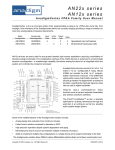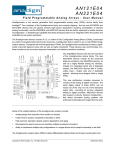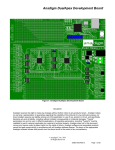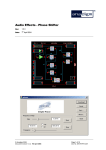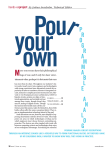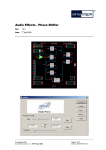Download App Note 202 Design Considerations in Mixed Signal
Transcript
App Note 202 Design Considerations in Mixed Signal System Boards This application note is for use in conjunction with Anadigm software which is subject to the terms of an Anadigm software license. This application note does not form part of any contract or specification between Anadigm and the user and is for guidance and illustration only. Accordingly, we accept no liability arising out of the use of the guidance note in conjunction with the software to the extent permitted by law. Introduction Designing a mixed signal system board, requires careful considerations related to routing signals, system partitioning and handling circuit grounds and power signals. This Application Note discusses some of these ® considerations to help you design Anadigm FPAA devices in such systems while achieving maximum performance. The following topics are covered in this Application Note: • FPAA technology background • Grounding and ground planes • Power planes, power decoupling and power distribution in mixed signal systems • Analog and digital signal paths • Clock distribution • Component selection FPAA technology background Anadigm®'s field programmable analog arrays (FPAAs) and design software introduce two new capabilities to the analog world. The first is the ability to translate complex analog circuits to a simple set of low-level functions, and thus to give designers the analog equivalent of an FPGA. The second is the ability to place analog functions under real-time software control within the system. By providing the analog equivalent of logic gates, FPAAs give designers the ability to describe analog functions such as gain stages and filters without reference to the underlying function - in other words, without having to think on the level of such components as op amps, capacitors, resistors, transconductors, and current mirrors. Lifted to this higher level of abstraction, the design process becomes so simple that non-specialists can create sophisticated circuits that would require weeks or months of design work with ASICs or discretes. Dynamic reconfigurability adds to these capabilities by allowing analog functions to be updated in real time using automatically generated C-code. With analog functions under the control of the system processor, new device configurations can be loaded on the fly, allowing the device's operation to be "time-sliced," or to manipulate the tuning or the construction of any part of Anadigm ® the circuit without interrupting operation of the FPAA, thus maintaining system integrity. ® To get more information on the Anadigm FPAA technology and our solutions, please visit our website at http://www.anadigm.com. Grounding and ground planes System Ground In a mixed signal system there are several different types of ‘ground’. One of them is the ‘system ground’, which all boards and modules in the system share. The most common problem within such systems is the ‘common ground impedance’ – illustrated in Figure 1. Circuit 1 Ground Current 1 Circuit 2 Common Ground Impedence Ground Current 2 Figure 1: Common Ground Impedance The figure shows how current flowing from circuit 1 to ground can potentially produce noise in Circuit 2, by modulating its ground potential. Such common ground impedances are created by ‘daisy chain grounding’. Instead ‘star grounding’ (shown in Figure 2) is recommended. Additionally all ground connections need to be made with large diameter wires or wide PCB traces. Daisy Chain Star Ground Figure 2: Daisy Chain vs. Star Ground AP020800-U202 ® Copyright © 2002 Anadigm , All Rights Reserved A pp Note 202 —Design Considerations in Mixed Signal System Boards Board Ground Traces Of most interest to board level designers are the common return currents of individual components. Any signal running on a PCB trace creates a return current, which flows through the ground connection. This return current follows the route of minimum impedance; it would prefer to run directly under the signal trace. Thus single layer boards normally do not show good analog performance. Even dual layer boards need careful layout of signal and return paths, to make them clean. Since wider traces have lower impedance, they are preferable for the current return path. The impedance of narrow traces can create a measurable voltage drop over the trace. This voltage drop would move the ground potential of the return currents source by the same amount, effectively changing the signal at the source. While a signal change of 5mV may be acceptable in a digital system, it is 0.1% of an analog full scale signal in a 5V single supply system. The optimum return path for a signal is a ground plane, where a complete layer is filled with copper, serving as a very low impedance ground connection. A ground plane, because of its low impedance, also greatly improves EMI performance. But there are still some rules, which have to be followed, to obtain best possible performance. Board Partitioning Consider a mixed signal system consisting of an ® Anadigm FPAA, an analog to digital converter, a digital signal processor and other digital and analog components. For the highest system performance, it is important to arrange the different blocks in a way that interac tion between the potentially noisy circuit blocks and sensitive analog circuits is minimized. • Group logic circuits according to the operating speed. Keep all high-frequency logic components close together, preferably close to the connector so that all high-frequency trace lengths are minimized. Short trace lengths reduce the amount of distributed capacitance and mutual inductance between signal routes. Place the low-frequency logic further away on the board, since longer trace lengths are acceptable. • Similarly, group and separate analog circuits according to frequency, minimizing the length of high-frequency signal paths. • Minimize the interface between the analog and the digital circuits by careful layout designed to minimize interaction. Anadigm ® Analog Circuits Logic Circuits Analog Interface Logic Interface Connector Analog Analog System Interface Circuits Clock Connector High Frequency Digital Low Frequency Digital Figure 3: Two ways of laying out a mixed signal board for highest system performance. Figure 3 shows two possible layouts of a mixed signal system board optimized for performance. In both cases, the system clock is located centrally to enable direct distribution of the clock signal with short traces and without through-holes. The higher frequency parts are as far away from the analog circuitry as possible, to avoid EMI. Ground Plane Rules and Layout A good way to ensure that the interaction between analog and digital signals will be minimized is to isolate the circuit areas on separate analog and digital ground planes. An analog plane will contain only analog circuits and the digital plane only digital circuits. The two ground planes should never overlap one another. If ground planes overlap, current will perfectly couple from one ground plane into the other. A multilayer board with power and ground planes is optimal, but not always practical. On a two layer board, the ground plane area should be maximized on both sides of the board by using trace fill on the signal side of the printed circuit board. Trace fill involves filling the open area between signal traces with copper and connecting this "mini-plane" to ground. Ground planes and trace fill can significantly reduce coupling. Power planes are designed using the same rules as ground planes. If power planes are used, never bridge the split between analog and digital ground. Keep the analog supply plane entirely under (over) the analog ground plane. This gives an analog supply plane over the analog ground plane and a digital supply plane over the digital ground plane. In four layer boards make sure that the power and ground planes are on the inner layers. Most PCB’s are thinner between layers 2 and 3, providing higher distributed capacitance. A power layer over a ground layer provides a very good decoupling capacitor, with almost ideal characteristics. This can drastically ease decoupling. Also having the signal trace on the outer AP020800-U202 Copyright © 2002 Anadigm®. All Rights Reserved A pp Note 202 —Design Considerations in Mixed Signal System Boards layers of the board is beneficial, as the inner layers with ground and power act as a very efficient shield to attenuate coupling between signal traces. A general rule is that the analog and digital ground planes should be separated by at least 3mm (I/8"). The gap between the ground planes is intended to minimize the distributed capacitance to a point where the interaction between the ground planes is minimal. This capacitance is based on the length of the ground plane as well as the separation. On small boards where the distance of the ground plane split is small, the gap width can be reduced. At some place in the circuit, the analog and digital grounds must be tied together to establish a common voltage for the digital interface between the analog and digital circuits. Proper selection of this connection point is crucial to maximizing system performance. One must attempt to keep the digital return currents that flow back to the regulator from passing through the analog circuits, and vice-versa. In this case the centralized location of the power supply regulation is beneficial; all power supply return currents have a direct path back to the regulators. In most layouts the best point to tie analog and digital grounds together is never completely clear. At the prototyping stage, pick numerous locations as likely candidates for the ground plane tie. Then experiment to determine which location maximizes analog performance, and use that point as the ground tie. Ideally a sec ond pass layout of the board will allow the ground tie to be permanently etched into the circuit board. A nice wide ground tie provides good connection between grounds at all frequencies. The inductance of a thin wire jumper will limit its effectiveness at high frequencies, and could pos sibly cause a shift in the ground potential between the two planes. Trenches in the ground plane can be used to direct ground return currents around sensitive areas of the analog section. For example the high-frequency ground currents of the audio converters and the FPAA can be kept away from areas, where the low voltage, lowfrequency signals are routed on the board. Such fractures can also be used, to control current flow between high current and low current circuit areas, and to isolate the noise from high frequency clocks. But do not put too many cuts into the ground plane, as they would disrupt the continuity of the current flows and limit the effectiveness of the ground plane. Mixed signal parts, like converters or FPAA’s should be placed close to the ground split, with the digital pins fac ing the split. In the past it was recommended, to place such IC’s over the split, with analog pin over the analog plane, digital pins over the digital plane, analog ground pins connected to the analog plane and digital pins connected to the digital plane. This is no longer recommended, for several reasons. One important reason is the fact, that analog and digital ground cannot be completely separated on the die. So it is possible, that Anadigm ® “analog” return currents flow out of the “digital” pin. Now this current needs to flow to the connection point of analog and digital ground, which might be down in the power supply. This can take a long time, which would create timing and noise problems. Power Considerations For performance reasons it is always highly recommend to use separate supplies for digital and analog circuitry. The digital supply should only be used for parts placed over the digital ground plane, i.e. all pure digital parts. The analog supply is used for all analog and mixed signal parts. It might look like a good idea, to use the digital supply for the digital pins of the mixed signal parts, but it is not, for the following reasons: Doing this would bring the noisy digital supply into the analog region. For most mixed signal parts a difference between analog and digital supply of more than 0.5V is not allowed. This can easily be exceeded with dual supplies, if both regulators are at the opposite tolerances and if noise on the supply adds up. It is recommended, to supply mixed signal parts as shown in Figure 4. 10 Ohm or Ferrite Bead Analog Supply Digital Supply Figure 4: Analog and digital power supply generation All analog IC’s need decoupling on power leads, to shunt both high frequency and low frequency noise residing on the supply voltage. It is generally rec ommended to use a low impedance ceramic, 10nF or 100nF (X7R or similar) in parallel to a large electrolytic capacitor 4.7uF or 47uF for each supply pin of each IC. The ceramic capacitor should be placed as close as possible to the device and connected with traces as short and wide as possible. The task of the ceramic (low impedance) capacitor is to filter out high frequency noise, so avoid all sources of inductance. Ground loops need to be minimized. Clock Distribution Avoid having several asynchronous clocks on one board; try to derive clocks from one system clock. The ® Anadigm FPAA contains clock dividers, to ensure that AP020800-U202 Copyright © 2002 Anadigm®. All Rights Reserved A pp Note 202 —Design Considerations in Mixed Signal System Boards all clocks, needed within the chip, can be derived from one master clock. If the system can synchronize to various clocks, i.e. externally provided and internally generated, make sure to switch off all unused clocks. Different clock oscillators running simultaneously can create horrendous problems in a high performance analog system. If more than one clock must be enabled, minimize trace lengths and isolate return currents to maintain high analog performance levels. Take advantage of physical separation by keeping all clock sources close together on the circuit board. Ground planes and trace fills can be used to reduce noise emissions by reducing transmitter loop area. The manner in which circuit traces are constructed affect clock emissions. Sharp corners and bends create concentrations of magnetic fields at the point of the bend. The corner or bend also affects the impedance of the trace at this point, ending in higher radiation at the bend, because of the discontinuity. Note that vias are harsh ninety degree corners in the trace. This is illustrated in Figure 5. Figure 5: Trace bend shapes The mixed signal components (e.g. the FPAA device) should be located completely over the analog ground plane, but close to the edge – the digital pins facing towards the ground plane split, in order to minimize the length of the digital trace over the analog ground plane, and to minimize the number of bends. In Figure 6 the analog and digital ground planes are connected at one location by a “bridge”. The digital signals to the mixed signal components over the analog ground plane are routed over the bridge. The affect of this routing is to have the digital return current follow a path under the signal traces resulting in a smaller effective loop area. Static Signal SDATA Processor MCLK Ground Plane Split FPAA FPAA Ground Plane Split FPAA FPAA Figure 6: Placement and Routing Illustration Component Selection Most analog functionality can be included in the FPAA, but there are still a few external components needed. These include Capacitors for power supply decoupling Capacitors in the signal path External amplifiers (could be necessary for signal adjustment) Power supply decoupling capacitors need to have good high frequency behavior, while drift over time temperature and signal amplitude are neglectable. For that reason X7R is a good choice for ceramic and Tantalum for electrolytic capacitors. It is different for capacitors used in the signal path. These could be used for AC coupling, frequency compensation or similar tasks. Here it is mandatory to have small drifts, especially the voltage coefficient has to be minimal. The voltage coefficient defines the variation of the capacitance over the applied voltage. Why is this important? If the capacitor is used in a filter, what is true in this case, and if it changes its capacitance over the applied voltage, the filter will change its frequency during a single sine wave period. This would introduc e distortion to the signal. Capacitors with NP0 or ZOG dielectric are optimal for this challenge. External amplifiers might be needed, to adjust the signal to the FPAA’s needs, i.e. amplify very small signal to an acceptable value, or level shift signal to VMR. Such amplifiers should be used in the inverting mode, as many op-amps introduce distortion in the non-inverting mode. Also metal film resistors are better suited than carbon resistors. Reference Voltages ® All Anadigm FPAA’s use a reference voltage, called VMR. This voltage is used to give an internal signal reference, around which the signal can swing. Effectively this is Signal Ground. VMR has to be handled very carefully. It needs to be decoupled externally with ceramic capacitors. These capacitors need to be placed as close to the pins as possible, minimizing loop areas. Anadigm ® AP020800-U202 Copyright © 2002 Anadigm®. All Rights Reserved A pp Note 202 —Design Considerations in Mixed Signal System Boards VMR is not designed to be used externally. However if you want to use this signal externally it needs to be buffered with a unity gain buffer amplifier. Again this amplifier should be placed as close to the chip as possible. It is also possible to provide an external reference ® voltage to most of Anadigm ’s FPAA’s. For further details please consult the AN220E04 user manual. Conclusion If these simple rules are followed, the design should work within the required accuracy. Since all the analog functionality can be implemented in the integrated FPAA platform, place-and-route within the analog partition of the system is easy. For more information, go to www.anadigm.com. Anadigm ® AP020800-U202 Copyright © 2002 Anadigm®. All Rights Reserved






